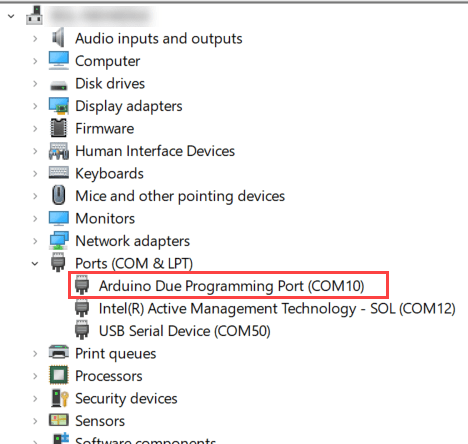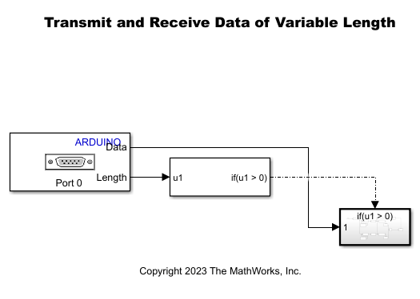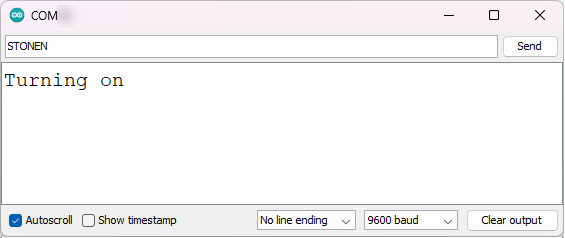Send and Receive Data of Variable Lengths Using Arduino Serial Communication Blocks
This example shows how to use the Serial Transmit and Serial Receive blocks from the Simulink® Support Package for Arduino® Hardware to transmit and receive data of variable lengths on the Arduino serial port using a USB to serial converter.
Prerequisites
For more information on how to use the Simulink Support Package for Arduino Hardware to run a Simulink model on your Arduino board, see Get Started with Arduino Hardware.
For more information on how to set up the Arduino hardware for serial communication, see Use Serial Communication with Arduino Hardware.
For more information on how to use the Arduino serial communication blocks for data polling, see Send and Receive Data Between Arduino and Host Using Serial Communication.
Required Hardware
Any Arduino hardware board
USB to serial device, for example, FTDI USB to serial device
Connecting wires
Install USB to Serial Device Driver
Follow these instructions to install a USB to serial FTDI driver.
Connect your system to the Internet, and then connect an FTDI device. If your system is connected to the Internet, the FTDI driver installs automatically once the FTDI device is plugged in.
Follow the installation guides to manually install the FTDI drivers.
Connect Arduino and USB to Serial Adaptor
To align the TX and RX pins correctly, as shown in the diagram, connect the TX on the USB to serial device to RX on the Arduino board and RX on the USB to serial device to TX on the Arduino board. If these are misaligned, the USB to serial device can go undiscovered.

View Arduino COM Ports on Host
To view the list of the available Arduino COM ports on your host computer, go to Start > Control Panel > Device Manager > Ports (COM & LPT). Enter this COM port value in the Port parameter in the block masks for the blocks used in this Simulink model. The COM ports shown in this figure are for illustration purpose and might vary for your host computer.

Configure Simulink Model and Calibrate Parameters
Open the arduino_serial_variable_length Simulink model.

This model transmits and receives data of variable length on the Arduino serial port. The Arduino serial port transmits a string of variable length when,
The header and terminator that encloses the data matches with the one you configure in the Serial Receive block.
The data enclosed in the message matches with the one you configure in the Simulink model.
For example, the Simulink model transmits the data 'Turning ON' to the Arduino serial port when the data received on the serial port is 'STONOFF' where, ST is the header, 'ON' is the data message, and 'OFF' is the terminator. Observe that the data 'ON' is two bytes while, the data 'OFF' is three bytes.

Arduino hardware is connected to the FTDI chip allows serial data transfers over USB with the host computer.
In the Configuration Parameters dialog box of the arduino_serial_variable_length Simulink model, go to Hardware Implementation > Target hardware resources > Serial port properties and set the Serial 3 baud rate to 9600.
Configure these parameters in the Serial Receive Block Parameters dialog box to receive data of variable length with a header and terminator.
Set Data length option to
Variable length.Set Header to
ST.Set Terminator to
EN.
Build and Deploy Simulink Model on Arduino Hardware
On the Hardware tab of the arduino_serial_variable_length Simulink model, in the Deploy section, click Build, Deploy & Start.
You can use the serial terminal on your host computer to view the output data. When logging in to the terminal,
Specify the COM port number that corresponds to your Arduino serial connection. For more information, see Manually Configure COM Port and Bootloader on Host.
Specify the baud rate to the same value as the baud rate set in the Configuration Parameters dialog box. In this example, the baud rate is
9600.
After you open the serial terminal, send two bytes of data 'ON' with a header 'ST' and terminator 'EN' in this format: STONEN and observe the output. The string matches with the properties set in the 'If Action Subsystem' and the output 'Turning ON' is displayed on the terminal.
Serial Terminal Output

Similarly, send three bytes of data 'OFF' in this format: STOFFEN and observe that the output 'Turning OFF' is displayed on the terminal.
Serial Terminal Output

You can also create a serialport to view the output in your MATLAB® session.
On the MATLAB Command Window, run this command to create a serialport object.
serialobj = serialport('COM3',9600,'Timeout',2)
serialobj =
Serialport with properties: Port: "COM3"
BaudRate: 9600
Tag: ""
NumBytesAvailable: 0Show all properties, functions
Write data ON to serial port.
serialobj.write('STONEN','uint8')Read data from serial port.
serialobj.readline
ans =
"Turning on"
Similarly, write data OFF to serial port.
serialobj.write('STOFFEN','uint8')Read data from serial port.
serialobj.readline
ans =
"Turning Off"
See Also
Send and Receive Data Between Arduino and Host Using Serial Communication